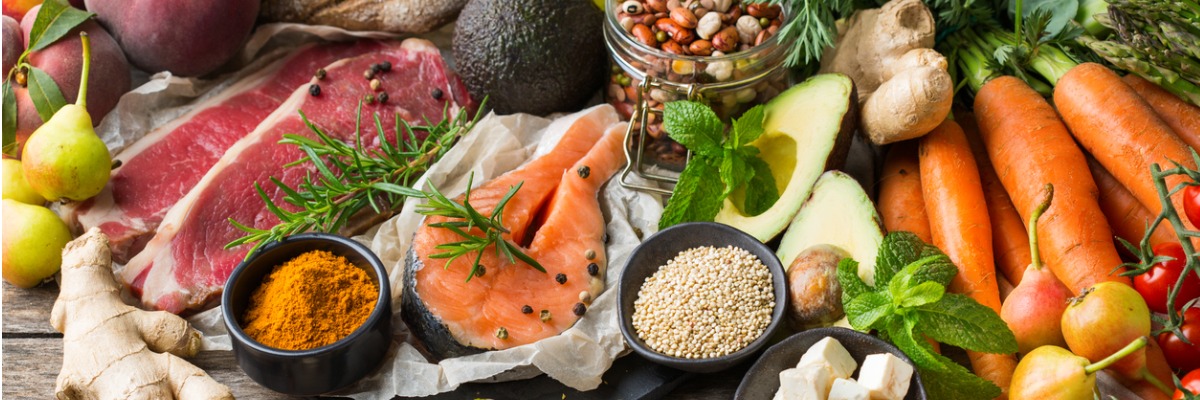Eat Whole, Natural, Unprocessed Foods

The number one rule when choosing foods is that if it grows from the ground, falls from a tree, can run, swim, or fly, then it is an optimal choice. Eating a variety of whole and natural foods can provide your body with all the recognized macro and micronutrient building blocks to create the impressive structure that is your body.
Imagine your body is a Ferrari, a fine-tuned, high-functioning machine. You wouldn’t fuel a Ferrari with low octane fuel, let alone highly processed fuels like hydrogenated vegetable oil. Instead, you would likely fuel your valuable machine with the fuel it was designed to run best on – high octane fuel.
When it comes to your diet, think about all the options available in nature that humans have had access to for thousands of years, and choose the unprocessed foods that make your body feel and function like that fine-tuned Ferrari.
We Are What We Eat
Macronutrients
Macronutrients are the main building blocks for the organs and tissues in the body, including our muscles, bones, brain, hormones, enzymes, immune cells, and more. There are three primary macronutrients:
- Proteins: composed of smaller amino acids, are the structural building blocks of muscles but are also used to make hormones, enzymes, energy, and immune cells like antibodies.
- Carbohydrates: can be broken down into smaller components of starch, cellulose, and sugar, which is the primary source of energy for the muscles and brain.
- Fat: an important structural unit for every cell wall and is a prominent component of neurological tissue. Fat also provides insulation and is a major and dense source of energy.
Micronutrients
Micronutrients are the smaller compounds that assist the macronutrients. Although they are needed in much smaller amounts, they are critical to our health, and deficiencies in any of them can be life-threatening. There are three main types of micronutrients:
- Vitamins: play important roles in energy production, blood clotting, immune function, antioxidants, and much more.
- Minerals: cannot be broken down and are vital structural components of all tissues, including bones and teeth. They also help with fluid balance, energy metabolism and even assist in hormone creation.
- Phytonutrients: nutrients derived from plants that have powerful antioxidant effects
Our body requires adequate amounts of both macro and micronutrients to function optimally.
Modernization of the Food Industry
For centuries, humans have chosen foods that were provided by nature. However, with the advent of technologically advanced farming methods and, most recently, the big business of manufacturing and processing foods, our dietary choices have significantly changed.
Today, processed foods account for up to 80% of caloric intake in the United States and Canada. Numerous studies have indicated that the more processed foods our diets contain, the greater the risk of non-communicable diseases, such as obesity, cardiovascular and metabolic diseases, cancer, depression, gastrointestinal disorders, premature mortality, and more.
Whole Foods
Whole foods are products that most closely resemble their natural form and retain their macro and micronutrients without any added ingredients. Whole foods include:
- Fresh fruits: apples, strawberries, bananas, raspberries, peaches, plums, etc.
- Fresh vegetables: broccoli, asparagus, carrots, kale, cauliflower, zucchini, etc.
- Nuts: hazelnuts, peanuts, almonds, pinenuts, walnuts, cashews, pistachios, etc.
- Animal foods from wild or grass-fed/pasture-raised sources
Minimally Processed Healthy Foods
Some foods that have been minimally processed may still be healthy and mostly pure, as long as there is no added sugar, salt, or other unnatural ingredients. Minimally processed foods may be better suited for travel and storage and may include foods that are:
- Dried
- Frozen
- Fermented
- Roasted
- Boiled
- Crushed
- Ground
- Filtered
- Pasteurized
- Chilled
- Vacuum-packed
Canned vegetables and beans can also fall into this category as long as they aren’t packaged in brine, which is a high concentration solution of salt, sugar, and water.
Processed Foods
As a food item becomes more processed, more micronutrients are stripped from the product, and the food becomes less healthy. Processing may include heating, the mechanical grinding of grain into flour, or the addition of preservatives. A whopping 60-80% of a food’s vitamins and minerals may be destroyed by processing, and the fortified nutrients they are replaced with often don’t resemble the forms that were present in the original product.
Processed foods usually have about two or three slightly modified versions of recognizable ingredients. Foods that fall under this category include:
- Tofu
- Most cheeses
- Processed meats: ham, bacon, smoked fish, pastrami, etc.
- Whole-grain bread
Processed foods can be successfully implemented into a healthy diet, but it comes down to the product’s ingredients.
Allergens in Processed Foods
The top five foods allergens include:
- Wheat or grains
- Dairy
- Soy
- Eggs
- Nuts
When eating processed foods, it’s important to read nutritional labels to watch out for any food ingredients that may cause a reaction. Remember, simply removing a nutrient that you know you are sensitive to, such as gluten, does not make processed food healthier. Furthermore, you may be sensitive to other components in the grain besides the gluten. In this case, it may be better to opt for whole food options.
Ultra-Processed Foods
Ultra-processed foods are manufactured products found on the grocery store shelves in brightly colored, highly enticing packages. These foods are calorie-dense, nutrient-poor, and their excess sugar and unhealthy fats and chemicals can increase your risk for diabetes, heart disease, obesity, and depression.
Any products where at least five ingredients have been modified are typically considered ultra-processed food. They usually contain artificially hydrogenated fats, emulsifiers, colorings, or other unnatural and unhealthy additives. Among the most common ultra-processed products include grains that have been refined into flour, such as:
- White bread
- Noodles
- Cereal flakes
- Crackers
- Pretzels
- Cookies
In contrast, whole grains like corn kernels, wheat, and brown rice contain bran, germ, and endosperm. In the refining process, the bran and germ are removed, which is where the bread’s fiber and micronutrients reside. As a result, only the endosperm remains, leaving a soft, chewy, highly palatable product packed with easily digested sugar, which increases blood glucose levels soon after eating.
How to Follow a Healthy Diet
The best way to follow a healthy diet is to balance your meals and snacks with the three macronutrients from whole foods as often as possible to reduce your risk of disease, increase your energy levels, and help ward off degenerative diseases. Remember to incorporate the following into your diet:
- Lean Proteins: fish, chicken, turkey, eggs, and hormone-free, free-range, or grass-fed red meat and dairy. Vegetarian sources include beans and legumes.
- Whole Vegetables and Fruits: green leafy veggies, asparagus, green beans, tomatoes, squash, zucchini, cucumbers, celery, broccoli, cauliflower, cabbage, berries, citrus fruit, peaches, pears, plums, nectarines, etc.
- Healthy Fats: raw unsalted nuts, seeds, olives, avocados, and their oils.
Contact Outset Health
If you are interested in providing your patients with more tips and tricks for their optimal health and nutrition, contact Outset Health to learn more about our healthy aging programs. At Outset Health, we are dedicated to helping your patients take control of their aging through nutritional and exercise plans and bioidentical hormone replacement therapy. Call (866) 461-3405 to schedule your demo today.
